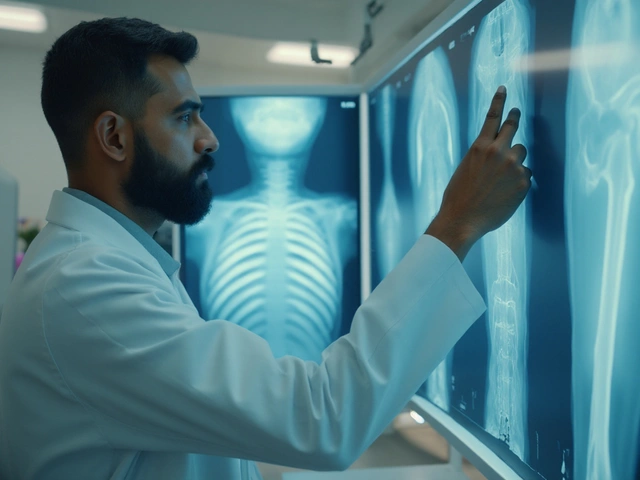Not many people talk about what really happens to your breasts during open heart surgery. You hear all about the heart and — let's be honest — that's the star of the show. But if you're someone with boobs, your mind might wander to what actually gets touched, moved, or changed during a chest operation. That's a fair question, and nobody should feel weird about asking.
Open heart surgery usually means a pretty big incision right down the chest. The surgeon has to open the breastbone to get to your heart. Now, unless you're talking about breast implants or huge size differences, most breasts aren't directly cut through. Surgeons are careful to part tissue, not slice anything up. But, the skin and underlying tissue, including the breasts, definitely get pulled and shifted during the process. That's why some people notice swelling, numbness, or tingling after waking up from surgery. It's not just about the heart — your whole chest can feel like a battlefield.
If you have small breasts, the process may feel different from someone with larger breasts, since bigger tissue can weigh down that incision or make wounds tougher to heal. Sometimes doctors even use special supports or extra chest wrapping, especially for those with bigger cup sizes, to keep the area protected. It's stuff like this that nobody mentions at the pre-surgery meeting, but honestly, it's super helpful to know what to expect.
- Breast Anatomy Meets Surgery Table
- How Surgeons Work Around Breasts
- Scars, Swelling, and Sensation Changes
- Recovery Tips: Realistic Expectations
- FAQ: Common Concerns and Surprising Facts
Breast Anatomy Meets Surgery Table
Most people don't realize how much the shape and size of your breasts matter during open heart surgery. Surgeons have to plan out every move to deal with this anatomy, so they don't mess up anything important along the way.
The breast sits over the chest muscles, and right underneath that is your breastbone—which is what the surgeon needs to reach. For open heart surgery, they cut through the skin right over the sternum, sometimes slightly shifting breast tissue out of the way. This is called a median sternotomy, and it’s pretty much the standard way to access the heart. The breasts themselves aren’t cut open, but the incision will often run right in between them, sometimes curving slightly if needed, especially for women with larger breasts.
Your natural breast size makes a difference here. Bigger breasts can actually block some of the view of the surgical area. That means the surgical team might have to carefully lift and tape the tissue aside or use extra padding so the area stays clear and the breasts don’t pull on the incision afterward.
Here's a quick cheat sheet on what goes into handling breast anatomy in open heart surgery:
- Incision Placement: Almost always runs down the breastbone, but can curve or shift to avoid larger breast tissue or implants.
- Positioning: The operating table is set so gravity and padding help move breast tissue away from the chest. Sometimes surgical tape helps too.
- Protecting the Breasts: Surgeons are careful to avoid pinching nerves, stretching skin, or injuring glands, since damage here can lead to numbness or swelling later on.
- Supporting Big Breasts: Special supports or wrappings keep larger breasts from tugging at fresh stitches, which makes a big difference for healing.
It’s not just about getting to the heart—it’s about making sure everything else bounces back after surgery. Most people don’t talk about this, but how your chest is set up matters a lot before, during, and after open heart surgery.
How Surgeons Work Around Breasts
When it comes to open heart surgery, the position of the breasts matters. Surgeons try their best to avoid any extra damage or complications. The basic game plan is to use a chest incision right down the middle, called a median sternotomy. That means the cut runs between the breasts rather than through them. The tissue gets parted, not sliced through, so the breast itself isn't opened up. Surgeons carefully move the breast tissue out of the way to get a direct line to the breastbone.
It sounds straightforward, but for folks with larger breasts, there’s an extra layer of work. Sometimes, tape or special supports are used to gently move the breasts to the side and keep them from falling into the way of the incision. This not only makes the surgeon's job easier but also reduces the risk of pulling or stretching the skin too much. For big-busted patients, some hospitals wrap the chest with a soft, elastic bandage after surgery to help with healing and keep swelling under control.
Here’s how the whole setup usually looks in the operating room:
- The patient lies flat on the operating table, arms usually tucked at their side.
- Any hair on the chest is shaved to lower infection risk.
- Special drapes cover the body with an opening for the surgical zone (between the breasts, not through them).
- If needed, gentle tape or foam pads are used to shift the breasts aside, but never in a way that’s going to cause long-term dents or marks.
Breast implants or previous surgeries can make things trickier, so surgeons plan for these ahead of time. They might get imaging or talk to a plastic surgeon before operating, just to know what they’re walking into. It's rare, but sometimes if there’s a really big implant or unusual anatomy, the surgeon might shift the incision a bit or coordinate with other specialties.
Here’s a quick look at common steps to protect breast tissue during heart surgery:
- Plan the incision for the least impact on breast tissue.
- Use physical supports to move or lift breast tissue out of the way.
- Extra padding under the breasts during surgery for comfort and circulation.
Fun fact — a study in 2022 found that adding a soft support under the breasts during open heart surgery lowered the odds of wound complications in women with larger breasts by almost 20%. It’s not high-tech, but it shows that little tweaks can make a real difference.

Scars, Swelling, and Sensation Changes
One of the most common questions after open heart surgery is about what kind of scars and changes are left behind—especially when it comes to breasts. The main scar usually runs right down the middle of your chest, often called a "sternotomy scar." If your breasts are larger, that scar sometimes curves or angles as it passes over the breast tissue. For smaller breasts, the scar usually stays pretty straight. Either way, the incision is stitched tight, and doctor's goal is to help it heal up strong, not pretty—but you can work on looks later.
Swelling is almost a guarantee. Right after surgery, you might wake up and find your whole chest looks puffier than usual. That's your body sending extra fluid to help everything recover. Usually, swelling starts to calm down over a week or two, but for some, it might hang around for a month. Bigger-breasted folks can notice more swelling underneath the breasts right on the incision line, which sometimes leads to a bit of fluid collecting there (called a seroma). If you’re worried about it, always ask your nurse to take a look—they see this stuff all the time.
Then there's the weird stuff nobody warns you about: numb patches or strange zings of sensation. Nerves running under the skin might get stretched or bruised during surgery, especially when the tissue has to be moved aside. It's not uncommon to have numb or tingly spots around the scar or on the lower part of the breasts for weeks—or even months. Most of these weird feelings fade as nerves heal, but sometimes, a little numbness sticks around. It’s not dangerous, just annoying.
If you want a real sense of what people experience, check out this rough guide based on patient reports:
| Symptom | How Common | How Long It Lasts |
|---|---|---|
| Swelling | Very common (80-90%) | 1-4 weeks |
| Numbness/Tingling | Up to 70% | Weeks to months, sometimes permanent |
| Visible scarring | Everyone (100%) | Permanent, but fades over 6-12 months |
Scarring is a fact of life with open heart surgery, but there are ways to help it heal better. Keep the area clean and follow any instructions about scar creams or silicone sheets. Don’t pick at scabs; they help protect. For swelling, propping yourself up when you sleep can help, and you might get a special support bra from the hospital. Most people agree: you eventually care less about the scar if your heart’s beating strong.
Recovery Tips: Realistic Expectations
The truth is, recovery after open heart surgery isn’t just about the heart. Your chest — including your breasts — needs special attention. Here’s what people really experience, and some straightforward tips to help you heal better.
First up, expect swelling and tightness in your chest. The incision is right down the middle, so both breasts can feel puffy, numb, or even tingly for weeks. If your breasts are on the larger side, support is crucial. Those first days, many women wear a soft, supportive bra (front-closing is often easiest) 24/7, even while sleeping, to take the pull off your chest and help with that heavy feeling.
- Wound care: Keep the incision clean and dry. Avoid lotions or powders right on the stitches. If you spot redness, swelling that gets worse, or strange smells, call your doc fast.
- Scar management: Once your doctor okays it and the wound has closed, simple things like vitamin E oil or silicone scar sheets can help long-term. Some folks get keloid scars, especially around the cleavage. Don't freak out if scars look thick — they usually flatten over time.
- Positioning matters: When getting out of bed or lifting your arms, move slow and steady to protect your chest and breasts. Ask your care team for "surgical hugger" tricks — holding a pillow against your chest if you need to cough or sneeze.
- Bra choice: Front-closing sports bras are MVPs in the weeks after heart surgery. Underwires can hurt, and avoid anything too tight.
- Activity: Don’t lift anything heavier than a carton of milk (about 2 kilograms) until cleared. This isn’t just about your chest bone, it’s also about letting your breasts and surrounding tissues settle back into place.
Here’s a quick look at when things usually happen after open heart surgery:
| Time After Surgery | What to Expect |
|---|---|
| Days 1-7 | Swelling, bruising, numbness. Soreness around breasts likely. |
| 2 Weeks | Incision still tender, some feeling returns. Most can shower carefully. |
| 1 Month | Swelling goes down. Numb spots slowly improve. Scar may look red. |
| 3-6 Months | Scars darken, flattens. Sensation mostly back, but numbness possible long-term. |
One last thing — everyone’s body is different. If you’re worried about how your breasts look or feel as you heal, talk to your doctor. There are options if you get chronic pain, ongoing swelling, or scars that bother you. None of these issues are weird or rare. And don’t beat yourself up if you need a little extra support, physically or emotionally. Recovery is a full-body thing, and you don’t have to go through it alone.

FAQ: Common Concerns and Surprising Facts
If you’re gearing up for open heart surgery, you’ll probably Google all sorts of things your surgeon never mentions. Here are honest answers to questions people ask all the time about what happens to breasts on the operating table and after.
Will I have a scar across my breasts?
The main scar almost always runs straight down the middle of your chest, not across the breasts. If you have larger breasts, the incision might curve a little at the bottom, but surgeons avoid cutting straight through breast tissue if they can. If you’ve had a previous breast surgery (like implants or reduction), let your surgeon know—some surgical plans or incisions may change.
Can breasts look different after surgery?
- There’s often some swelling around the chest incision area, which can make things look uneven for a few weeks.
- Numbness or tingling around the scar or below it is common. Most of the time, this fades over months, but for about 10% of people, it sticks around longer.
- If you have larger breasts, it’s easier for the incision to pull or stretch, especially with gravity. Support bras or pillows can help big time with healing.
What about breastfeeding after open heart surgery?
Open heart operations rarely hurt the milk ducts if the incision stays in the middle. If surgeons have to go around the side of the breast or if your surgery is super complex, double-check with your team, but most women can still breastfeed once they’re healed and off certain meds.
Are there any long-term effects?
- For most people, breasts go back to their usual shape and feel within 6–12 months.
- Some folks can get hypertrophic (raised, itchy) scars. These are more common if you have darker skin tone or a family history of thick scars.
How do people manage discomfort and protect the incision?
- Support bras—soft, no wires—help take pressure off the scar.
- Pillow-hugging when coughing or getting up is a classic move for a reason. It protects your chest and eases pain.
- Some hospitals hand out little heart-shaped pillows for this exact reason. If you don’t get one, a small, firm cushion works just as well.
Table: Common Post-Op Breast Concerns After Open Heart Surgery
| Concern | How Common? | Usually Temporary? |
|---|---|---|
| Swelling around breasts | 70% | Yes |
| Numbness | 30% | Usually |
| Scar pulling/stretching | 20% | Sometimes |
| Lasting shape change | 5% | No |
Here’s a tip nobody tells you: Snap a photo before surgery, and again during recovery. That way, you can see if changes are just in your head or if you need some extra support from your care team.
If something doesn’t look right, speak up—nurses and surgeons have seen it all. Feeling weird or embarrassed about the changes won't help as much as getting real answers.
Worried about infection around the scar under the breasts? Keep the area clean, let it air out, and don’t skip follow-up appointments. Catching a problem early is easier than fixing it later.





